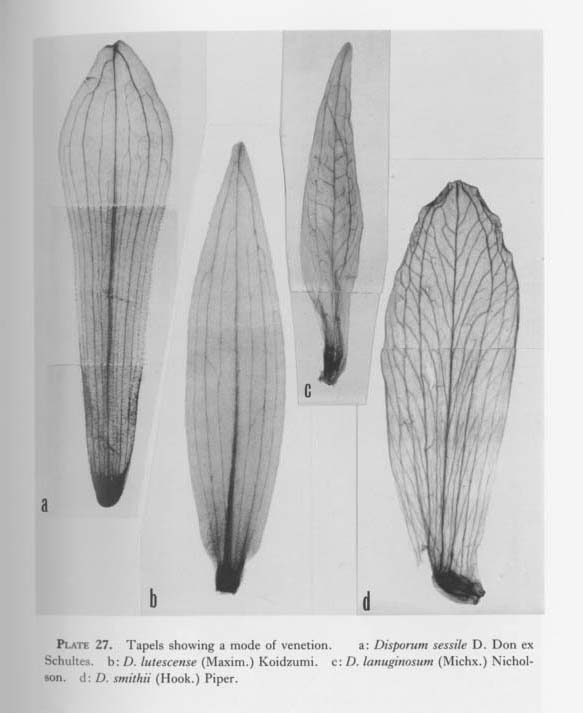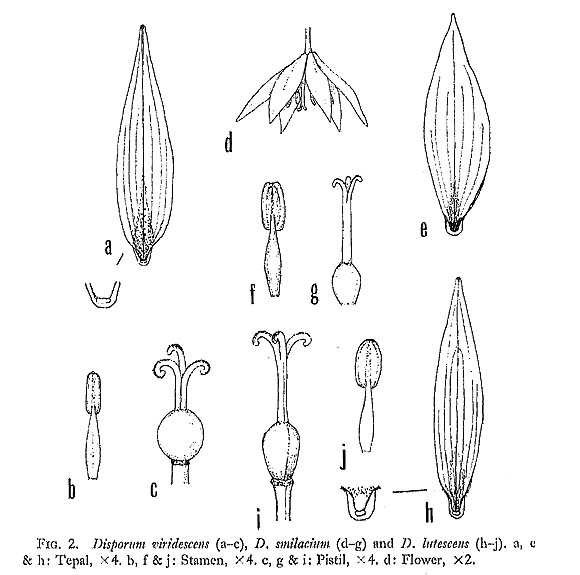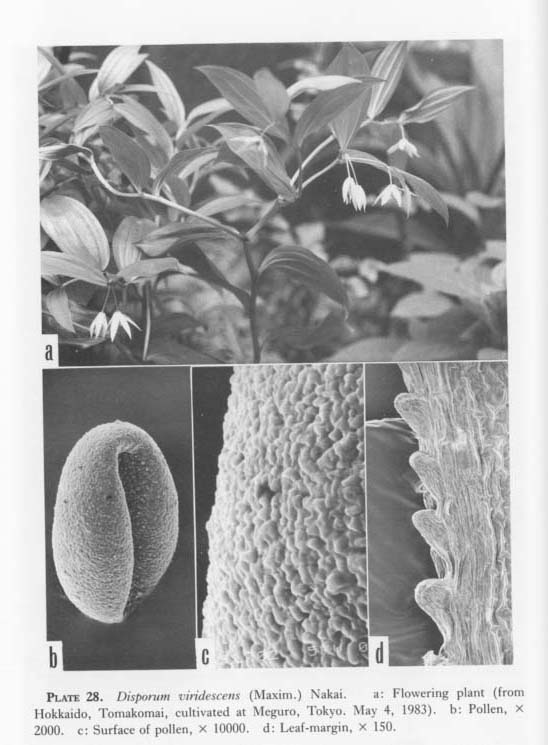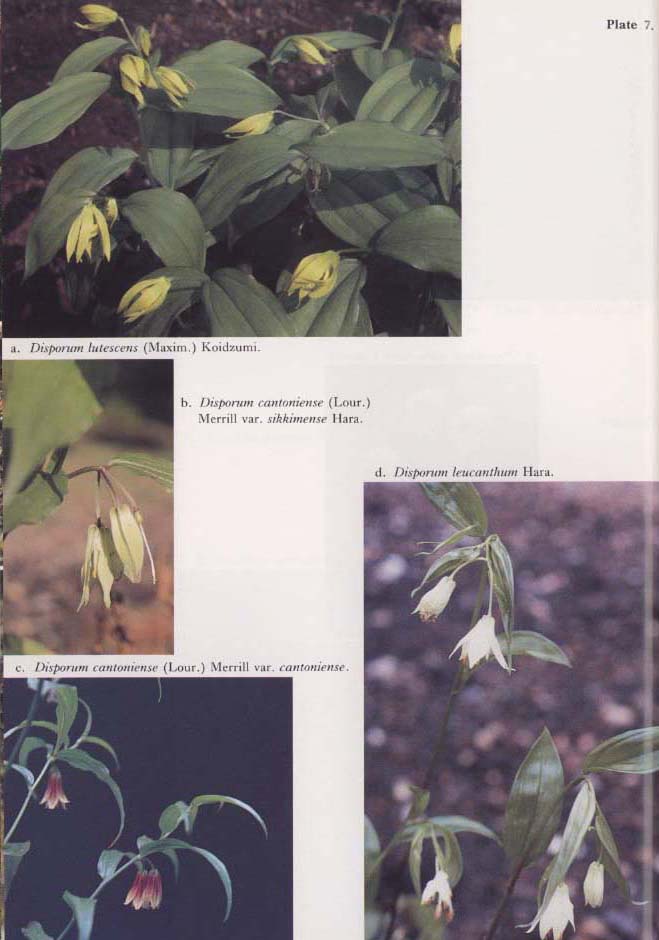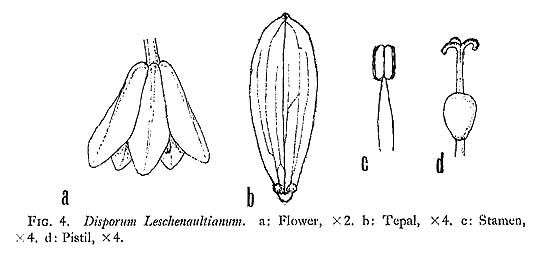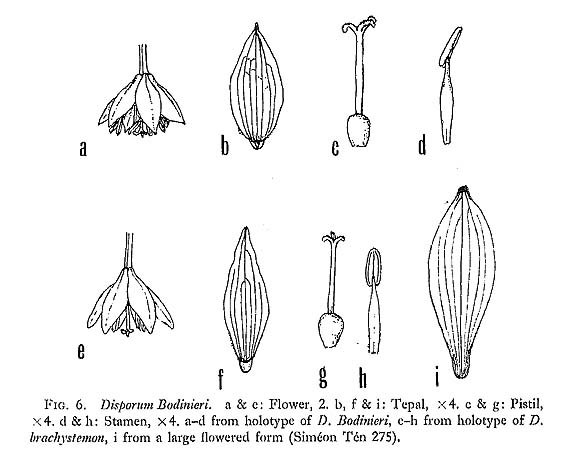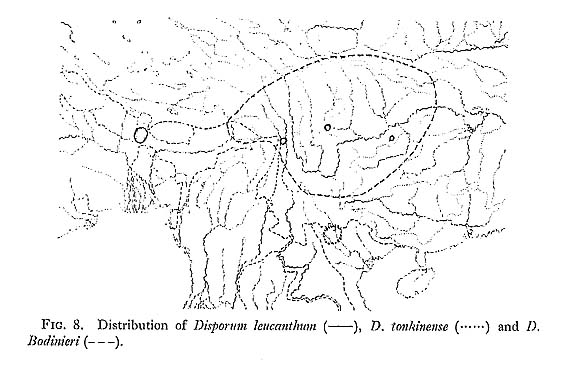A REVISION OF THE ASIATIC SPECIES OF THE GENUS DISPORUM (LILIACEAE)
Hiroshi HARA †
| ( 1 / 3 ) |
|
The name Disporum pullum was first given for a Chinese plant by Salisbury in 1812, but it was not described. Then Smith (1818) treated the plant under Streptopus, and Wallich (1820) under Uvularia. The genus Disporum was first validly published by D. Don in 1825. He then prepared a monograph of the genus in 1839 and 41, including 8 species from Assam, Himalaya, and China. On the other hand, D. Don (1839 & 41) described simultaneously a new genus Prosartes based on two North American species which have been included in Streptopus or Uvularia, and pointed out that the genus has introrse anthers, nearly entire stigmas and pendulous ovules. Later Baker (1875) observed that it really has extrorse anthers. Bentham and Hooker (1883) united Prosartes with Disporum, pointing out that Disporum trachycarpum has horizontal ovules affixed in the middle, as is seen also in a Himalayan species, and that both groups agree in all other characters. Since then this opinion has been adopted by most subsequent authors. In 1951 Jones critically revised the genus of North America, and he divided the genus into two sections: Sect, Eudi-sporum (about 12 species) of Asia and Sect. Prosartes (5 species) of North America. According to Jones' definition, Sect. Eudisporum is composed of glabrous plants with narrow and shortly petioled leaves, pseudo-lateral inflorescences, yellowish white or purplish flowers, tepals spurred at the base, stigmas usually deeply 3-lobed, ascending ovules, dark-blue or black berries, and several larger chromosomes. Sect, Prosartes of North America consists of pubescent plants with lanceolate to ovate and subsessile leaves, terminal inflorescences, yellowish or greenish white flowers, tepala truncate or slightly gibbose at the base, entire or slightly 3-lobed stigmas, pendulous or horizontal ovules, reddish or straw-coloured berries, and small chromosomes. In Asia several additional species have been published by Léveillé, Merrill, C. H. Wright, Gagnepain, Wang et Tang, Ohwi, Kitagawa, and T. Koyama. With the in crease of knowledge it became clear that some Asiatic species have broad leaves, terminal inflorescence, tepals slightly gibbose at the base, or stigmas slightly 3-lobed at the apex as in the North American species. Moreover, Disporum acuminatum C. H. Wright from Burma and D. ovale Ohwi from Korea and North China have very unique characters in the genus. D. ovale somewhat resembles Streptopus amplexicaule having a slender creeping rhizome, leaves am-plexicaul at the base, and glandular-ciliate on the margin, tepals not saccate at the base, and red fruits. But it is distinguished from Streptopus in having always terminal in florescences, longer filaments, fewer ovoid smooth seeds, etc. D. acuminatum, now known from a single specimen from Burma, is very striking in that the tepals have a distinct semi-globose protuberance on each side of the midvein at about 3 mm above the base. After having examined all Asiatic species hitherto described, I have come to the conclusion that it is reasonable to divide the genus into 4 sections. For this study I have examined a large number of specimens of the genus in Japan, China, and Europe. Especially I wish to express my sincere thanks to the curators of the following herbaria who gave me facilities for examining specimens in their charge: British Museum (Natural History), London (BM) ; Royal Botanic Garden, Edinburgh (E); South China Institute of Botany, Academia Sinica, Kwangchow (IBSC); Royal Botanic Gardens, Kew (K); Kunming Institute of Botany, Academia Sinica, Kunming (KUN); Department of Botany, Faculty of Science, Kyoto University, Kyoto (KYO); Laboratoire de Phanerogamic, Museum National d'Histoire Naturelle, Paris (P); Institute of Botany, Academia Sinica, Peking (PE) ; Faculty of Agriculture, Hokkaido University, Sapporo (SAPT); Department of Biology, Sichuan University, Chengdu (SZ); Department of Botany, National Science Museum, Tokyo (TNS). Disporum Salisb. [in Trans. Hort. Soc. Lond. 1: 331 (1812), nom., illeg., sine descr.] ex D. Don, Prodr. Fl. Nepal. 50 (1825); in Proc. Linn. Soc. Lond. 1: 45 (1839); in Trans. Linn. Soc. Lond. 18: 515 (1841)-Schultes, Syst. Veg. 7: 370 (1829)-Kunth, Enum. Pl. 4: 206 (1843)-Baker in Journ. Linn. Soc. 14: 588 (1875)-Benth. et Hook. f., Gen. Pl. 3(2): 831 (1883)-Jones in Contr. Gray Herb. 173: 10 (1951)-Hara in Enum. Flow. Pl. Nepal 1: 72 (1978)-Jassop in Fl. Males. 9: 217 (1979). Drapiezia Blume, Enum. Pl. Jav. 1: 8 (1827). Perennial herb, glabrous or pubescent. Rhizome thickened with fleshy roots, or slender and long-creeping. Stem erect, simple or branched (often dichotomously) in the upper part, with one to several sheathing bracts in the lower part, and with normal leaves in the upper part. Leaves alternate, sessile or shortly petioled, linear to roundish. Inflorescence terminal, or in appearance lateral, i.e. terminal on a short lateral branchlet opposite to a leaf. Flower solitary to umbellate, on slender inarticulate pedicel, without bract, rotate to cylindric-campanulate, drooping or spreading. Tepals 6 in 2 similar series, subequal, free, oblanceolate to obovate, whitish, greenish, yellow, or dark purple, often saccate or spurred at the base, caducous with stamen. Stamens 6, included or exserted, inserted on the very base of tepal; filaments often filiform, sometimes thickened in the lower part; anthers generally oblong, basifixed, extrorse, laterally dehiscent. Pollen grains monocolpatc (in D. calcaratum 2-4-colpate), with reticulate exine, some times with tuberculate muri. Ovary obovoid or globose, 3-celled; ovules 2-6 per locule; style filiform, 3-lobed in the upper part, with, 3 stigmas. Berry subglobose or slightly 3-coccoua, blue-black or red in mature, Seeds globose or ovoid, smooth, with stony endocarp. Lectotype: Disporum pullum Salisb. =D). cantoniense (Lour.) Merrill. Key to Sections
Disporum Sect. 2. Prosartes (D. Don) Q. Jones in Contr. Gray Herb. 173: 11 (1951). Prosartes D. Don in Proc. Linn. Soc. Lond. 1: 48 (1839); in Trans. Linn. Soc. Lond. 18:531 (1841). More or less pubescent, with simple, multicellular, or rarely stellate-glandular hairs. Inflorescence terminal. Flowers subrotate to cylindric-campanulate, yellow, greenish, white, sometimes purple-spotted. Tepals lanceolate to elongate oblong (-oblanceolate), acutish at the apex, slightly gibbose or truncate at the base; veins anastomosing with distinct often oblique connecting veinlets. Stigmas subentire, or slightly 3-lobed. Ovules pendulous, or horizontal, 2-6 per locule. Berries red, or yellow. Chromo somes 2n=12, 16, 18, 22, 32, all small. Lectotype: Disporum lanuginosum (Michx.) Nicholson. 5 species in North America. As in Sect. Disporum (cf. p. 168), the species of this section are quite variable in the shape of leaves, the shape of flowers, the shape and colour of tepals, and the length of stamens and style. However, the range of morphological variations is narrower in North America as compared with that in Asia. The North American species, although isolated on western and eastern sides of the continent, have some common characters. I noticed that in the mode of venation of the tepal the North American species are different from the Asiatic species. As shown in Plate 27, the tepals of the North American species have anastomosing veins with distinct oblique veinlets, as exemplified in Disporum Smithii (Hook.) Piper of western North America (Plate 27d). Even. in a narrow lanceolate tepal of D, lanuginosum (Michx.) Nicholson of eastern North America, a similar tendency of the mode of venation is observed (Plate 27c). In comparison with them, a broad tepal of D. sessile of Japan has parallel main nerves with only a few sparse connecting veinlets (Plate 27a).
On the other hand, in Sect. Prosartes, the mode and degree of pubescence arc very variable, and the chromosome numbers are different almost specifically, and the cyto-taxonomical relationships among the North American species seem to remain not yet fully settled. Disporum Smithii of North America resembles D, sessile of Japan in flower shape and chromosome number, and is sometimes considered to be related to the latter. But these similarities can be attributed to pallallel evolution in North America and Asia rather than to a direct relationship between the two species. The American species are assumed to have been differentiated in North America. Key to the Asiatic species and varieties of Disporum
Dispomm Sect. 1. Disporum. Glabrous, sometimes scabrous. Inflorescence terminal or pseudo-lateral. Flowers rotate to cylindric-campanulate, white, greenish, yellow, or dark purple. Tepals lanceolate to obovate, mostly gibbose, or spurred at the base; main veins of tepal parallel with sparce transverse connecting veinlets. Style with 3 short stigmas at the apex, or deeply 3-cleft up to the middle. Ovules ascending. Berries dark blue to black. Chromosomes 2n=14, 16, 30, including a few pairs of larger chromosomes. Lectotype: Disporum pullum Salisb.=D. cantoniense (Lour.) Merrill. About 16 species in Aaia, from Himalaya and Tibet east to China, Korea, Usauri, and Japan, and south to Ceylon and Malaysia. 1) Disporum viridescens (Maxim.) Nakai, Fl. Korea. 2 (Journ. Coll. Sci. Univ. Tokyo 31): 246 (1911)-Honda in Bot. Mag. Tokyo 44: 318 (1930)-Kitagawa, Lineam. Fl. Mansh. 135 (1939)-Satake in Journ. Jap. Bot. 17: 501, fig. A & B (1941)-Ohwi, Fl. Jap. 318 (1953); ed. Eng. 305 (1965); ed. rev. 373 (1965)-Okuyama, Col. Ill, Wild Pl. Jap. 1: 63, t.31.3 (1957)-Kitamura et al., Col. Ill. Herb. Pl. Jap. 3: 109 (1964)-Wang et Tang in Fl. Reip. Pop. Sin. 15: 42, t.15.4 (1978)-Satake et al., Wild Flow. Jap. 1: 48, t. 45.1 (1982). [Plate 28; Figs. 2a-c, 3]
Uvularia viridescens Maxim., Prim. Fl. Amur. 273 (1859). D. smilacinum A. Gray sensu Baker in Journ. Linn. Soc. 14: 590 (1875), p.p.-Yabe in Bot. Mag. Tokyo 17: 135 (1903), p.p.-Voroschilov, Fl. Soviet Far East 124 (1966). Nom. Jap. O-chigoyuri. Rhizome slender, with densely tufted roots at the apex, later with long creeping stolons. Stem 20-70 cm high, 3-5 mm thick, often branched in the upper part, green, almost terete, 2-7 leaves below the first branching. Leaves ovate or elliptic, the upper ones oblong-lanceolate, (4)5-12 cm long, 1.5-5 cm wide, acuminate or acute at the apex, broadly cuneate or roundish at the base, deep green, glabrous, minutely scabrous on margin, light green beneath, very shortly petioled. Inflorescence terminal, 1-2-flowered. Pedicels declining, 5-18 (20) mm long, slender, terete, smooth. Flowers nodding, greenish white, infundibuliform, widely opening, 2-2.5 cm in diameter. Tepals lanceolate or broad lanceolate, 10-18 mm long, 2-5 mm wide, long attenuate to the apex, 2-3 mm wide and slightly saccate at the base, smooth and finely 7-nerved. Stamens 6, 1/2-2/3 of tepals, 4-6(8) mm long; filaments 1.5-6 mm long, thickened in the lower part, greenish; anthers oblong, 2-3 mm long, versatile, yellow, very minutely apiculate. Style 3-5 mm long, greenish white, deeply trifid often to the middle; branches 3(2), often 3-4 mm long, papillose inside. Ovary subglobose, 2.5-3 mm long, green, 1-2 ovules per locule. Berries globose or obscurely 3-coccose, ca. 1 cm in diameter, black in mature. Fl. late Apr.-Jul. Fr. Aug.-Oct. Chromosomes 2n=16 (Kurosawa, 1983). In forests, alt. 10-850 m. Hokkaido, Honshu (Tohoku to Chubu distr.), Korea, North China, and Ussuri. REPRESENTATIVE SPECIMENS. HOKKAIDO. Kushiro: Pashikuru, Shiranuka-cho, 10 m (K. Takita no. 1029, Jun. 19, 1982, fl., KYO). Iburi: Tomakomai (H. Hara & S. Kurosawa, Sep. 2, 1980, TI; cult. in Tokyo, H. Hara, May 21, 1984, TI). HONSHU. Iwate: Mt. Tabaahine-yama (H. Iwabuchi no. 6204, May 17, 1938, fl., TI); Mt. Ureira, Iwaidzumi-cho, 100 m (T. Shimizu, Jun. 9, 1957, KYO). Tochigi: Mt. Idzuru-san, 500 m (H. Hara, May 3, 1958, fl., TI); Kiyotaki, Nikko (H. Ohba & S. Akiyama no. 1223, Jun. 6, 1980, TI). Gunma: Haraichi, Usui-gun (T. Nakajima, May 23, 1934, fl., KYO); Sanbaishi, Tano-gun (Y. Satake, May 21, 1941, TNS). Saitama: Chichibu (R. Yatabe & J. Matsumura, Apr. 29, 1878, fl., TI); Mt. Buko-san, 500 m (M. Togashi & T. Yamazaki no. 6701, Jun. 1, 1962, TI). Tokyo: Shinharamachida (T. Naka-jima, May 26,1929, fl., KYO). Nagano: Izuhara, Ichida-mura, 600 m (K. Asano, May 18,1957, fl., TI); Oshika-mura (K. Katsumata, Jun. 1, 1930, fl., TI); Chuo, Urugi-mura, 850 m (K. Asano no. 11476, Oct. 4, 1954, TI). Yamanashi: Yoshida, Mt. Fuji (K. Hisauchi, Jul. 24, 1928, fl., TI); Sengenjinja, Yoshida (S. Sugimoto, Jun. 8, 1934, fl., KYO); Oshino (J. Satoh, Jun. 12, 1978, fl., TI). KOREA. Heihoku: Hakuheki-san (T. Ishidoya, Jun. 4, 1945, fl., TI). Kogen: Bokuho (T. Uchiyama, Aug. 12 & 13, 1902, fr., TI); Hyokunji, Mt. Kongosan (T. Nakai no. 5240, Aug. 13, 1916, TI). Keiki: Mt. Nankansan (T. Uchiyama, Oct. 18, 1900, TI); Koryo (T. Mori no. 41, Jun. 2, 1912, fl., TI; H. Hara, Sep. 11, 1983, fr., TI); Kwazan, Suigen (T. Nakai no. 4779, May 1917, fl.; no. 3092, Sep. 4, 1915, fr., TI). Keinan: Mt. Chii-san (S. Okamoto, Jun. 13, 1935, TI; K. Ueda et al., no. 1128, Jun. 23, 1979, KYO, TI). CHINA. Kirin, Ryutansan (J. Sato no. 9217, Jun. 7, 1929, fl., PE); Botanko-sho, Kyohakuko (K. Abe, Jun. 8, 1940, fl., PE); Hoten, Nanryo (Y. Yabe, Aug. 25, 1909, TI); Mucdanensis fluv. Jalu-dsian (V. Komarov, Aug. 13, 1897,fr.,TI);Ryoyo, Senzan (Y. Tabe, Aug. 1909, fr., TI; ? no. 267, May 24, 1956, fl., PE); Teikaho (M. Kitagawa, Jun. 8, 1932, fl., TI). This species is distinguished from Disporum smilacinum A. Gray in having generally more robust, branched and terete stem with 3-7 leaves below branching, greenish white flowers, acutish or obtuse leaves, shorter style which is generally deeply 3-lobed, and globose ovary. But the style is variable in Korea, and it is generally deeply 3-lobed with the connate part 1.5-2.5 mm long, and rarely lobed nearly to the base, while it is very rarely 4-4.5 mm long with only short stigmas 1 mm long. 2) Disporum smilacinum A. Gray in Perry, Exped. Jap. 2: 321 (1857); Bot, Jap. 414 (1859)-Baker in Journ. Linn. Soc. 14: 590 (1875), p.p-Maxim. in Bull. Acad. Sci. St.-Pét. 29: (1883), excl. β. et r.-Miyabe, Fl. Kuril. 265 (1890)-Nakai, Fl, Korea. 2: 245 (1911)-Loesener, Prodr. Fl. Tsingt. 101, t. 2, H-J (1919)-Miyabe et Kudo, Fl. Hokk. & Saghal. 3: 334 (1932)-Hara in Bot. Mag. Tokyo 52: 461 (1938)-Satake in Journ. Jap. Bot. 17: 502, fig. C (1941)-Ohwi, Fl. Jap. 318 (1953); ed. Eng. 305 (1965); ed. rev. 373 (1965)-Okuyama, Col. Ill. Wild Pl. Jap. 1: 41, t. 20.2 (1957)-Kitamura et al., Col. Ill. Herb. Pl. Jap. 3: 109, t. 28.188 (1964)-Masamune, Col. Ill. Fl. Nippon 8: 70, figs. (1969)-Vorobiev et al., Key Vasc. Pl. Sakhal. & Kuril. 119 (1974)-Wang et Tang in Fl. Reip. Pop. Sin. 15: 44, t. 15.5 (1978)-Satake et al., Wild Flow. Jap. 1: 48, t. 44.6 (1982). [Plate 29; Figs. 2d-g, 3]
D. smilacinum &altha;. album Maxim., l.c. 29: 215 (1883)-Makino in Bot. Mag. Tokyo 11: (282) (1897)-Mataumura, Ind. Pl. Jap. 2(1): 195 (1905). Nom. Jap. Chigoyuri. Rhizome slender, creeping, with densely tufted roots at the apex, in summer with long slender creeping atolons up to 20-30 (45) cm long. Stem 8-35 cm high, 1-3 mm thick, generally simple, sometimes 1-3-forked in the upper part, only 1 or 2 normal leaves below the branching, and 6-8 leaves above the branching, green often dark purplish, angulate, often declining. Leaves ovate or elliptic to oblong, rarely roundish, (2)3-6(9) cm long 1-3(5) cm wide, green, slightly lustrous above, glabrous, often glaucescent beneath minutely scabrous on margin, shortly acuminate to long-acute at the apex, roundish or broad cuneate at the base, 3-7-nerved, very shortly petiolate. Inflorescence terminal, l-2(4)-flowered. Pedicel slender, 7-22 mm long, smooth, subterete or slightly angulate. Flowers generally declining or spreading, white, greenish near the base, infundibuliform, widely opening, 1-3 cm in diameter. Tepals lanceolate to broad lanceolate, (8)10-15(18) mm long, 2-4.5 mm wide, white and yellowish in the middle of the lower part, long-attenuate to the apex, slightly narrowed to the base, slightly saccate at the base, smooth. Stamens much shorter than tepals, 5-8(9) mm long; filaments greenish white, 4.5-7 mm long, thickened below the middle, 1-1.2 mm thick; anthers narrow oblong, 2-3.5 mm long, yellowish, versatile. Style 4-6.5 mm long, generally as long as stamens, sometimes shorter or longer, white, generally shortly trifid at the apex, rarely deeply trifid. Ovary obovoid, 2.5-3 mm long, green, 1-2 ovules per locule. Berries subglobose or broad ellipsoid, 8-10 mm long, 7-10 mm in diameter, blue-black in mature. Seeds subglobose, 4-5 mm long, brownish, smooth. Fl. Apr.early Jul. Fr. Sep.-Oct. Chromosomes 2n=16. In open forests, alt. 10-1600 m; South Kuriles (Urup, Etorof), South Sakhalin (Kaibato), Hokkaido, Honshu, Shikoku, Kyushu (south to Yakushima), Korea, and East China (Shantung). REPRESENTATIVE SPECIMENS. KURILES. Urup Is., Tokotan (M. Tatewaki, Sep. 3, 1927, SAPT); Is. Etorof, Tsurubetsu (K. Miyabe, Jul. 28, 1884, SAPT). Sakhalin. Kaiba Is., Kitakotan (U. Ohki et al., Jul. 21, 1931, SAPT). HOKKAIDO. Kitami: Is. Rebun, Motochi (M. Tatewaki, Jul. 11, 1920, SAPT). Tokachi: Toyoni, Hiroo, seaside (S. Okamoto, Aug. 31, 1963, TI). Hidaka: Mt. Apoi (H. Hara, S. Kurosawa & Y. Tateishi, Sep. 13, 1974, TI). Ishikari: Makomanai (M. Hara,Jun.3,1943, fl.,TI). Oshima: Onuma(T. Yamazaki, Jul. 11, 1956, TI). HONSHU. Aomori: Mt. Shirakami-dake, 1000 m (H. Ohba et al., Jul. 14, 1975, TI); Harada, Sai-mura (O. Mori, Jun. 6, 1957, TI). Iwate: Kuzakai, 600 m (T. Morita, May 27, 1973, fl., TI). Akita: Monzen, Oga Penin. (N. Satomi, Aug. 30, 1964, TI). Yamagata: Mt. Hagurosan (F. Maekawa & H. Hara, Jun. 12, 1937, TI). Miyagi: Suzugamori, Kurihara-machi (H. Ohashi et al., May 27, 1981, fl., TI); Masuzawa, Daiwa-cho (H. S. Ogura no. 2767, May 19, 1972, TI). Fukushima: Tonokuchi, Inawashiro (S. Hattori, Jul. 10, 1926, fl., TI). Ibaraki: Mt. Tsukuba (M. Honda, May 4, 1924, TI). Tochigi: Mt. Mitsumine (H. Hara, May 4, 1958, TI). Gunma: Mt. Kanosan (J. Murata et al. no. 105223, May 20, 1983, TI). Tokyo: Mt. Kariyose (T. Nakai, May 8, 1930, fl.-type of D. smilacinum var. ramosum Nakai, TI); ibid. (T. Nakai, May 8,1930-type of D. smilacinum var. variegatum Nakai ex Satake, TI); Asakawa (I. Hurusawa, Apr. 29, 1939, fl., TI); Is. Miyake-jima, Tsubota-mura (Y. Jotani no. 33, Aug. 11, 1934, TNS). Chiba: Mt. Kiyozumi (S. Asano, May 3, 1961, TNS). Niigata: Hachizaki (N. Satomi, May 3, 1960, TI). Nagano: Shimajima-dani (S. Momose, Jul. 23, 1935, TI). Yamanashi: Mitsu-toge, 1200 m (H. Ohashi no. 8002, May 24,1968, fl., TI). Shizuoka: Mt. Ryuso-san (T. Omura, May 15,1958, fl.-type of D. smilacinum var. rotundata Satake, TI); Mt. Iwatake, Haruno-cho (G. Murata et al. no. 88, Apr. 29, 1972, fl., TI). Aichi: Arao, Shitara-cho (K. Torii, May 3, 1967, fl., TI). Gifu: Kanzaki, Miyama-mura (H. Hara, May 7, 1961, fl., TI). Toyama: Mt. Sogatake, 1000 m (N. Nagai, Jul. 3, 1960, TI). Ishikawa: Mt. Hotatsu-san, Noto (M. Kumazawa, May 8, 1933,fl., TI); Mt. Hakusan (K. Nakano, Jun. 16,1952, fl.,TI). Mie: Okukahada-kyo (H. Hara&S. Kurosawa, May 1, 1976, fl., TI), Wakayama: Mt. Koya-san (H. Ohashi no. 68669, May 13, 1968, fl., TI). Kyoto: Mt. Aoba-yama, Maizuru (N. Satomi, Apr. 29, 1961, fl., TI). Osaka: Mt. Kongo-san, 900 m (M. Togashi, May 24, 1968, fl., TI); Honzanji, 500 m (N. Naruhashi et F. Konta no. 38, May 9, 1965, fl., KYO; TI). Tottori: Mt. Daisen (M. Furumi, Jul. 29, 1926, TI). Shiroane: Fuse-mura, Oki (M. Furumi, Jul. 20, 1927, TI); Mt, Senbe-yama (K. Midorikawa, May 16, 1981, fl., TI). Okayama: Shitoyama, Takahashi (Z. Yoshino, May 4, 1960, fl., TI), Hiroshima: Fukuojisan, Kabe-machi (K, Enomoto, May 3, 1969, fl., TI), Yamaguchi: Tsubakigo Higashikokubu-mura (J. Nikai, Jun. 9, 1920, TNS); Higashihata, Ato-machi (J. Murata no. 10873, May 1, 1981, fl., TI). SHIKOKU. Tokushima: Jinryo-mura (K. Abe no. 13, May 1, 1938, fl., TI). Ehime: Mt. Ishizuchi (K. Kondo, May 20, 1928, TI). KYUSHU. Oita: Aigo-mura (Y. Nabeshima, Sep. 23, 1936, TI; TNS). Nagasaki: Ariake-san, Tsushima (Y. Yabe, Aug. 23, 1901, TI). Kumamoto: Mt, Fukaba-yama (H. Kozuma no. 31172, Jun. 3, 1906, TNS). Kagoshima: Mt. Shibisan (N. Satomi, Aug. 15, 1957, TI). KOREA. Kogen: Mt. Kongosan (T. Nakai nos. 5238 & 5239, Jul. 31, 1916, TI). Keiki: Hokukan-san (N. Okada, May 26, 1912, fl., TI); Nanzan (T. Uchiyama, Sep. 1, 1902, TI). Keinan: Haein-se (M. Sugiyama, May 11, 1968, fl., TI); Miroku-san, Toei (T. Nakai no. 10835, May 13, 1928, fl., TI). Zennan: Mt. Hakuyo-san (T. Nakai no. 1030, May 3, 1913, fl., TI). Quelpaert: Hoatien (T. Taquet no. 9199, May 1911, fl., TI); Hallaisan (T. Nakai, May 10, 1913, fl.,TI). CHINA. Shantung: Mt. Kunyu Shan, Yantai (Zhou no. 419 & 750, May 7 & 9, 1959, fl., PE). In the nothern part of Japan (Hokkaido, Tohoku, Hokuriku, and a few others), the species is growing in the lowlands, and even on the coast. The plants there have taller stems up to 30-40 cm high, and larger and broader acuminate leaves up to 7-8.5 cm long and 4-5 cm wide. A robust branched plant of this species sometimes closely resembles D. viridescens in appearance. A specimen collected from Kozeki-mura, Fukushima Pref. (T. Suzuki no. 5, May 27, 1935, fl., TI) has robust stems up to 45 cm high, and 3 leaves below the branching, but the style is 6 mm long, and shortly trifid at the apex. I could not confirm the reports that Disporum smilacinun occurs in W Szechuan: Wa-schan (Weigold 1915) by Handel-Mazzetti (1936), and in Amami-oshima by Masamune (1957). The species is common on hills and mountains of Japan, and is quite variable. The stem is often simple and declining, but sometimes ascending and forked in the upper part (var. ramosmn Nakai). Well-grown and branched individuals are sometimes found in a population mostly consisting of simple-stemmed individuals, while in some populaions branched individuals are dominated, but are not distinct enough to treat as a separate taxon. Forma variegatum (Nakai ex Satake) Hara with white-variegated leaves is rarely found in Honshu. A form with almost orbicular leaves is rarely found, and named as var. rotundatum Satake. But it is difficult to separate them clearly, as transitional forms between them are often found. The style is longer than stamens in some populations and shorter in some others, but it is still uncertain if there is any difference in fertility between them. 3) Disporum lutescens (Maxim.) Koidzumi in Bot. Mag. Tokyo 33: 112 (1919)-Satake in Journ. Jap. Bot. 17: 504 (1941)-Ohwi, Fl. Jap. ed. Eng. 305 (1965); ed. rev. 373 (1965)-Kitamura et al., Col. Ill. Herb. Pl. Jap. 3:109, t. 28.189 (1964)-Satake et al., Wild Flow. Jap. 1: 48, t. 45.2 (1982). [Colour plate 7a; Plate 29; Figs. 2h-j, 3]
D. smilacinum A. Gray r. lutescens Maxim. in Bull. Acad. Sci. St.-Pét. 29: 216 (1883)-Makino in Bot. Mag. Tokyo 11: 282 (1897)-Matsumura, Ind. Pl. Jap. 2(1): 195 (1905)-Ohwi, Fl. Jap. 318 (1953). Nom. Jap. Kibana-chigoyuri (Makino 1897). Rhizome slender, with thick tufted roots at the apex, later with long creeping stolons. Stem 10-35(60) cm high, thin, 1-3 mm thick, simple or forked in the upper part, with 1-2 normal leaves below the branching. Leaves elliptic, oblong or ovate, 3-12 cm long 1-4 cm wide, acuminate or acute at the apex, caudate-acuminate in the upper leaves, roundish or broad-cuneate at the base, glabrous, slightly scabrous on the margin. Inflorescence terminal, 1-2 (3)-flowered, sessile. Pedicels 8-17 mm long, slightly angulate. Flowers slightly nodding, obconic, widely opening, yellow and greenish in the lower part. Tepals lanceolate, 10-18 mm long, 2-3.5 mm wide, acute at the apex, slightly saccate at the base, minutely papillose on lower margin and inside near the base. Stamens 6, distinctly shorter than tepals, 6.5-8 mm long; filaments 4-6 mm long, greenish, thickened in the lower part; anthers narrow oblong, 2.5-3 mm long, yellow. Style 6-7 mm long, greenish white, distinctly trifid, with branches 3 mm long. Ovary obovoid, 3 mm long, green. Berries subglobose, blue-black in mature. Fl. Apr.-Jun. (Jul.). Fr. Sep.-Oct. Chromosomes 2n=16 (Hara & Kurosawa, 1963). In open forests on mountains, alt. 400-1000 m. Honshu (Kii Penin., rare), Shikoku (western part, rare), and Kyushu. REPRESENTATIVE SPECIMENS. HONSHU. Wakayama: Mt. Koya (Z. Tashiro, Jun. 18, 1926, fl., KYO;TNS; Y. Ogawa, May 9,1958, fl.,TI; T. Nakajima, May 1918 & Jun. 1921, fl.,TI; cult. in Tokyo, H. Hara, Apr. 28, 1983, fl., TI) ; Mt. Inunaki-yama (S. Nakanishi, May 24,1970, KYO) ; Ohji-dani, Akitsugawa, Tanabe-shi (H. Manago, May 6, 1979, fl., KYO). KYUSHU. Fukuoka: Mt. Koshosan (Y. Nabeshima, Jun. 6, 1926, TNS). Kumamoto: Watari, Kuma-mura (K. Mayebara no. 1875, May 18, 1924, fl., TI); Kukino-mura (H. Takahashi, Sep. 22, 1934, fr., TI; S. Watanabe, May 3, 1974, fl., TI); Mt. Noke-eboshi-dake (Z. Tashiro, Oct. 3, 1915, TNS); Shimizudera, Takamori (T. Tominari, May 9, 1975, fl., TI). Miyazaki: Satohara-toge (S. Hirata, Jul. 20, 1949, fl., TI); Konomine, Miyakonojo (K. Inamori, Jun. 19, 1951, fl., TI); Yamanokuchi-mura (T. Doi no. 2, May 15, 1932, fl., KYO); Mt. Horaga-take (Z. Tashiro, Apr. 23, 1915, TNS). Kagoshima: Mt. Odake, Is. Shimo-koshikijima (Y. Doi no. 16, Aug. 18, 1934, TI); Mt. Takakuma (T. Naito, Sep. 5, 1922, fr., TI; G. Koidzumi, Apr. 1923, fl., Kyo); Hondo-kokuyurin, Higashikokubu-mura (Z. Tashiro, May 28, 1917, KYO; TNS). This species is closely allied to Disporum smilacinum A. Gray and has a similar karyotype, but differs from the latter by greenish yellow flowers, minutely papillose on lower margin and inside near the base, and always angulate pedicels, and the upper leaves tend to be elongate and caudate-acuminate at the apex. 4) Disporum Leschenaultianum D. Don in Proc. Linn. Soc. 1: 45 (1839); in Trans. Linn. Soc. 18: 518 (1841)-Royle, Ill. Bot. Himal. 386 (1840)-Kunth, Enum. Pl. 4: 207 (1843)-Wight, Icon. Pl. Ind. Or. 6: t. 2048 (1853)-Baker in Journ. Linn. Soc. 14: 590 (1875)-Thwaites, Enum. Pl. Ceyl. 338 (1864)-Hook. f. in Bot. Mag. 113: t. 6935 (1887); Fl. Brit. Ind. 6: 360 (1892)-Trimen, Handb. Fl. Ceyl. 4: 289 (1898)-Fyson, Fl. Nilg. & Pulmey Hill-tops 1: 417 (1915); 2: t. 264 (1915)-C. E. C. Fischer in Gamble, Fl. Pres. Madras 3: 1063 (1957). [Plate 30; Figs. 4, 5]
Uvularia Leschenaultiana Wall., Cat. no. 5089 (1832), nom. nud. Rhizome decumbent, without slender stolon. Stem 25-90 cm high, rigid, often purplish, with 5-7 sheathing scales in the lower part, dichotomously branched with leaves in the upper part; branches spreading, acutely angled. Leaves ovate to ellipticlanceolate, or roundish, 3-10 cm long, 1-5 cm wide, abruptly acuminate or caudate at the apex, roundish at the base and attenuate to a distinct petiole, slightly lustrous, very slightly scabrous on margin, 5-9-nerved, transverse veinlets often distinct. Inflorescence terminal, 2-5-flowered. Pedicels decurved, 1-4 cm long, angular, undulate. Flowers nodding, broad obconic or open-campanulate, white, widely opening, 1.2-2 cm in diameter. Tepals oblong to broad oblong, 10-15 mm long, 3-5 mm wide, obtuse and mucronulate at the apex, 3-ribbed and slightly saccate at the base, keeled by the midrib, 7-nerved, papillose-scabrous on margin and midrib. Stamens shorter than tepals, 6-8 mm long; filaments nearly as long as or longer than anthers, 4-6 mm long, stout; anthers oblong, 2-3 mm long. Ovary obovoid, 2.5-3 mm long; style 4-5 mm long, stout, with 3 recurved stigmas 1.5 mm long. Berry depressed globose, 1.5-2 cm in diameter, very slightly 3-lobed, dark blue. Seeds subglobose. Fl. Mar.-Sep. In forests; South Western India (Western Ghants, Nilghiri Hills, alt. 900-2250 m) and Ceylon (Sri Lanka, alt. 1200-2200 m). SPECIMENS EXAMINED, INDIA. Mont Neelgherries (Leschenault, Wallich no. 5089-type of D. Leschenaulti.anum D. Don, K-w). CEYLON (SRI LANKA). Nuwara Eliya dist., Horton Plains, 2100 m (F. R. Fosberg no. 50047, Mar. 28, 1968, fl., us; TI); ibid., 7100ft. (T. Koyama no. 13634, May 14, 1968, fl., NY; TI). This species does not grow in the Himalayas, and the locality 'Mussooree' cited by Royle (1840) seems to be a mistake, also a plant collected by him is a doubtful one. Disporum Leschenaultianum occurs in the south-western part of Indian subcontinent far from other allied species, and is clearly recognized by elliptic leaves, large white flowers, oblong tepals obtuse at the apex and scabrous on margin, included shorter stamens with thick filaments and short anthers, and large depressed globose dark blue berries 1.5-2 cm in diameter. A narrow-leaved form was named as var. angustifolium C. E. C. Fischer, l.c. 1063 (1957). The leaves are linear-lanceolate and cauclate-acuminate at the apex. 5) Disporum Bodinieri (Lév. et Van.) Wang et Tang in Contr. Inst. Bot. Nat. Acad. Peip. 6: 20, in nota (1949). [Plate 31; Figs. 6, 8]
Tovaria Bodinieri Lév. et Van. in Mem. Pont. Accad. Romana dei Nuov. Lincei 23: 360 (1905). Perennial with thick fasciculate roots. Stem 12-60 cm high, with 5-6 vaginate leaves in the lower half, simple, or branched in the upper part, when branched, without normal leaf below the final branch. Leaves broad ovate to lanceolate-oblong, (2)3-6 cm long, 1-4 cm wide, abruptly acuminate or acutish at the apex, roundish at the base, often minutely papillose or sometimes minutely cellulate on margin, with short petiole 2-5 mm long. Inflorescenae terminal, umbellate, sessile, 2-6-flowtircd. Pedicels 6-15 (20) mm long, ridged, minutely papillose, sometimes almost smooth. Flowers nodding, broad obconic, 7-13 mm in diameter, greenish yellow, rose, violet or dark purple or (?) white, 2-3 mm in diameter at the baae. Tepals broad oblanceolate or ovate-lanceolate, (6)8-12 mm long, 2.5-4 mm wide, somewhat obtuse sometimes retuse or apiculate at the apex, 5-7-nerved, very minutely papillose on margin, shortly (0.6-0.8 mm long) gibbose at the base. Stamens slightly shorter or as long as the tepal, (5)6-8 mm long; filaments 3-4.5 mm long, lanceolate, ca. 0,8 mm wide in the middle, tapering to the apex, minutely papillose in the lower part, sometimes almost smooth; anthers narrow oblong, 3-4 mm long. Ovary obovoid, 2-3 mm long; style 3-6 mm long, shortly trifid at the apex. Berries depressed globose, 7-10 mm in diameter. Fl, May-Jun. Fr. Aug.-Oct. In scrubs or forests, often in rocky places, alt. 1200-3000 m; West China (NW Yunnan, S Szechuan, Kweichou, Hunan). REPRESENTATIVE SPECIMENS. CHINA. Yunnan: Likiang Hsien, 2800-3000 m (C. W. Wang no. 71338, Jul. 1935, fl.-type of D. brachystemon Wang et Tang, PE); ibid. 2800 m (C. W. Wang no. 71373, Jul, 1935, fl. greenish yellow, PE); Yunnan (Ducloux no. 3782, fl., PE); Lantsong Hsien, 1500 m (C. W. Wang no. 76555, May 1936, fl. purple, PE); Fo-hai, 1520 m (C. W. Wang no. 73697, May 1936, fl., PE); Mt. Ta-hai-tse, 3000 m (E. E. Maire no. 192, May 1913, fl., E; PE); Tcheou-kia-tse-tang, 2990m (E. E. Maire no. 453, May 1913, fl., E); Kiu-tsong-chau, 2550 m (E. E. Maire no. 1078, Jun. 1913, fl., E); Ouei-cha (Yungsi) (Siméon Tén no. 155, May 14, 1920, fl. flavi, E); Uaufautschoang (Siméon Tén no. 275, Jul. 13, 1920, fl. flavi, E); Ahsi, NW Lichiang Snow Range on Yangtze (R. C. Ching no. 20745, Jun. 9, 1939, fl. yellow, PE); S Muli, Ku-tsun, 3000 m (T. T. Yuuml; no. 5787, May 27, 1937, fl. light green, PE); Hsi-chang (T. T. Yü no. 1126, 1932, fl., PE). Szechuan austr., prope Oti (C. Schneider no. 1163, Jun. 2, 1914, fl., E); Mt. Jinfo-shan, 1450 m (Xiong & Li no. 90596, Apr. 28, 1957, fl. white, PE). Kweichou: Gan-pin (E. Bodinier no. 1546, Apr. 29, 1897, fl.-type of Tovaria Bodinieri Lév. et Van., E); Liou-chan-down, Anshun (S. W. Teng no. 0206, 1937, fl. light green, PE). Hunan: Long-shan, Wu-ya-tuo, Yen-jia-hao, 1200 m (L. H. Lion no. 01744, May 20, 1958, fl. white, PE). The type of Tovaria Bodinieri (Fig. 6a-d) has simple stem, ovate-lanceolate leaves with almost smooth margin, almost smooth pedicels, 'white' flowers, ovate-lanceolate tepals with apiculate tip, stamens nearly as long as tepals, almost smooth filaments ca. 5 mm long. While Disporum brachystemon has generally branched stem, often broader leaves abruptly acuminate at the apex and minutely papillose-scabrous on margin, minutely papillose pedicels, greenish, rose or dark purple flowers, stamens shorter than the tepal, broad-oblanceolate tepals somewhat obtuse at the apex, and shorter (3-4.5 mm long) filaments minutely papillose in the lower part. But some specimens are intermediate showing different combinations of those characters mentioned above, and it is difficult to separate the specimens into two distinct entities, and the stability of some characters can be checked only in the field, A plant mounted on the specimen (Siméon Tén no. 275) has larger flowers with ovate-oblanceo-late (12mm×4mm) and somewhat apiculate tepals (Fig. 6i) on the left branch, and small (young?) flowers with oblong-oblanceolate (8 mm×3 mm) and obtuse tepals on the right branch. |
